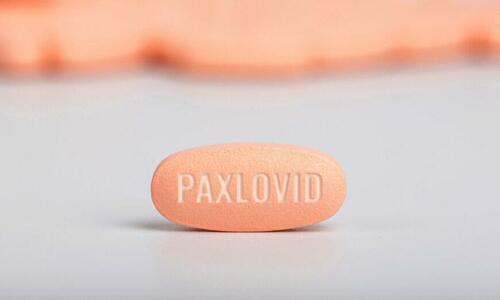9 Things You Need To Know About Paxlovid
Authored by Dr. Yuhong Dong via The Epoch Times (emphasis ours),
Do you know when Paxlovid should be used to treat COVID-19? Are you aware of the reasons for the mixed results of its phase 2 and phase 3 clinical trial data versus its real-life studies? Do you know what the most significant concern about Paxlovid is for its future application in treating COVID-19?
Reputed as a so-called “game-changer” oral antiviral pill to treat COVID-19, Paxlovid can prevent hospitalization and death in people who are at high risk of severe COVID-19. However, you should know that the research findings on Paxlovid are not always what they seem to be.
We will provide a balanced, unbiased review related to Paxlovid’s development history, clinical trial and real-world effectiveness data, and the drug’s advantages and limitations. We will also clarify the connection between oral antivirals and human immunity.
Summary of Key Facts
-
Paxlovid Is Not Yet Approved by the FDA
-
Paxlovid Should Be Used Soon After Virus Infection
-
Clinical Trial: 89% Efficacy With Side Effects of Dysgeusia and Diarrhea
-
Paxlovid Doesn’t Work in Younger Patients
-
In a Real-World Study, Paxlovid Has Shown Limited Effectiveness
-
Finding “Treatable” Patients Has Proven Challenging
-
Drug Resistance Is a Major Concern
-
Another Major Concern Is Paxlovid’s Interaction With Other Drugs
-
Natural Immunity Influences the Success of Paxlovid and Other Antivirals
Pfizer’s Paxlovid contains two active ingredients. The first is nirmatrelvir (PF-07321332), a protease inhibitor that interrupts the viral replication cycle.
The action of viral protease is like a pair of scissors in the hands of a tailor. The protease can cut the long synthesized viral protein (like a piece of cloth) into various fragments with different functions. The virus will combine these protein fragments into a complete virus particle.
When the protease of the virus is inhibited, the virus is not able to replicate successfully; thus, protease is often treated as a therapeutic target by the pharmaceutical industry.
The other active ingredient of Paxlovid is an old HIV drug, ritonavir. Ritonavir is an HIV protease inhibitor that can help slow down the metabolism or breakdown of nirmatrelvir, thus maintaining nirmatrelvir’s effective concentrations.
1. Paxlovid Is Not Yet Approved by the FDA
On Dec. 22, 2021, the FDA issued an Emergency Use Authorization (EUA) for Paxlovid (nirmatrelvir tablets co-packaged with ritonavir tablets) to treat mild-to-moderate COVID-19.
On June 30, 2022, Pfizer filed a New Drug Application (NDA) with the FDA, seeking approval for Paxlovid. As of today, however, it has not been approved by the FDA for the treatment of COVID-19.
2. Paxlovid Should Be Used Soon After Virus Infection
A group of researchers, mainly from Pfizer Worldwide Research, published an article in Science on Nov. 2, 2021, about the discovery and characterization of Paxlovid. In vitro antiviral activity of Paxlovid has been evaluated in multiple cellular models. In vitro testing showed that Paxlovid demonstrated potent antiviral activity against SARS-CoV-2, MERS-CoV, and other similar coronaviruses.
However, the researchers noted that Paxlovid should be given very soon after a subject is infected with COVID-19.
When given to mice as early as four hours after infection with SARS-CoV-2, a 300 or 1,000 mg/kg treatment of Paxlovid was effective in reducing the SARS-CoV-2 viral load in the lungs.
This means Paxlovid should be taken as early as possible post-virus infection. That is also the rationale for the inclusion criteria: only patients within five days of symptom onset were recruited in phase 2 and phase 3 clinical trials. In other words, if the viral infection is in a late stage and the illness is more severe, Paxlovid may not be as helpful as it is for early infection.
It is worth mentioning that the start time of giving Paxlovid treatment, four hours after the virus infected animals, was even shorter than another antiviral, molnupiravir, which was dosed at 12 hours and 36 hours after virus infection in animals.
3. Clinical Trial: 89% Efficacy With Side Effects of Dysgeusia and Diarrhea
The findings of phase 2–3 double-blind, randomized, controlled trial supported by Pfizer were published on Feb. 16, 2022, in the New England Journal of Medicine.
The trial involved 2,246 symptomatic, unvaccinated, non-hospitalized adult patients who were at high risk for developing severe COVID-19 symptoms, and symptom onset was no more than five days. They were randomly selected to receive either Paxlovid 300 mg with other standard care or a placebo with other traditional medicine twice a day for five days.
The final analysis, involving 1,379 patients, showed that Paxlovid reduced the risk of COVID-19-related hospitalization or death by 89 percent, compared to the placebo group when given less than five days after symptom onset.
The main side effects observed with Paxlovid vs. control were dysgeusia (a taste disorder, 5.6 percent versus 0.3 percent) and diarrhea (3.1 percent versus 1.6 percent), both higher than the placebo group. This indicates potential side effects on the neurological and gastroenterological systems.
Again, consistent with the development concept of this drug and aligned with its animal data, the drug has to be taken at an early stage of infection. Most patients (66.3 percent) received the first dose of the trial drug or placebo within three days after the onset of symptoms.
In the real world, not many patients can take the drug in the first onset days, especially during the current Omicron era, as most patients may view their symptoms as a common cold and may not be aware of having contracted COVID-19.
Read more here...
https://ift.tt/Xgr9OyB
from ZeroHedge News https://ift.tt/Xgr9OyB
via IFTTT





0 comments
Post a Comment